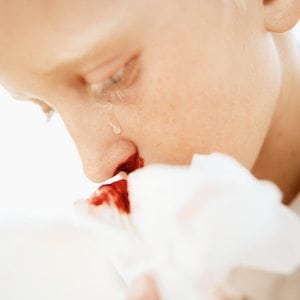When the air gets dry, nosebleeds are more likely to occur. Children are the most susceptible. Fortunately there are easy tips for handling your children’s nosebleeds.
In most cases, a nosebleed occurs because the tiny vessels inside the nose have broken. This type of nosebleed, called an anterior nosebleed, occurs because the blood flows out of the front (or anterior) part of the nose.

These types of nosebleeds are usually not serious and generally stop by themselves or require only simple steps to stop the bleeding; they rarely require medical attention. Anterior nosebleeds are almost always a result of an irritation inside the nose caused by several factors, including:
- Extremely cold and/or dry air, which dries out the mucous membranes of the nose.
- Dust, pollen, or other allergens.
- Frequent or forceful blowing of the nose or picking the nose.
- Foreign objects placed inside the nose.
- A blow to the nose.
- Inflammation due to the common cold or flu.
- Chronic use of nasal steroids.
Posterior nosebleeds, on the other hand, are much less common and occur when the blood flow comes from deep inside the nasal cavity and moves down the back (or posterior) of the mouth and throat. They are usually a sign of a more serious underlying medical condition, such as high blood pressure, hemophilia, or other bleeding disorders. Blood-thinning medicines can also cause posterior nosebleeds.
Children and teenagers are most susceptible to anterior nosebleeds, although adults can experience them as well. If your child has a nosebleed that does not stop quickly by itself, the American Academy of Pediatrics (AAP) recommends that you take the following steps:
- Stay calm, otherwise you could upset the child
- Keep your child sitting or standing and leaning slightly forward. If your child lies back, the blood will flow down the throat and this could make your child vomit
- Do not try to stuff tissues or other material into the nose to stop the bleeding. Instead, firmly pinch the soft part of the nose, using a cold compress if you have one or using your fingers. Keep the pressure on for a full 10 minutes. Do not look to see if the bleeding has stopped during this time because you may start the flow again
- If the bleeding has not stopped after 10 minutes, repeat the pressure for another 10 minutes
- If the bleeding persists after the second try, call your pediatrician or take the child to the nearest hospital emergency department.
The AAP also notes that while most nosebleeds are benign, a child with severe or recurrent bleeding, or bleeding from both nostrils, should be evaluated by a pediatrician and, if necessary, an ear-nose-throat specialist. Once the bleeding has stopped, have the child keep his head elevated and avoid heavy exertion and nose-blowing for at least an hour.

